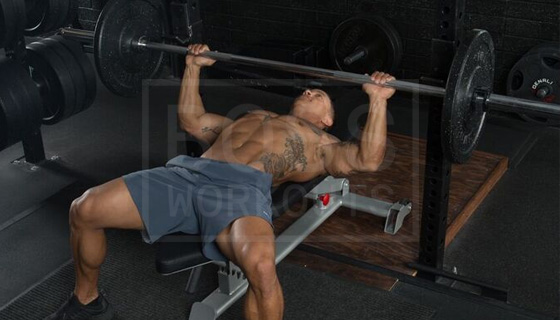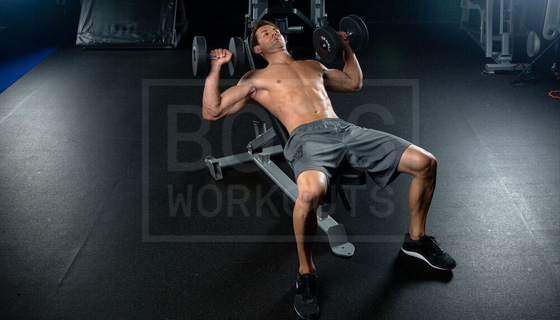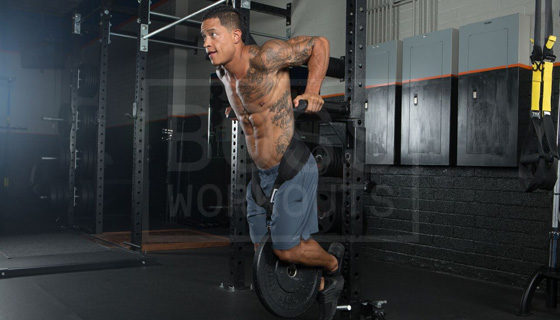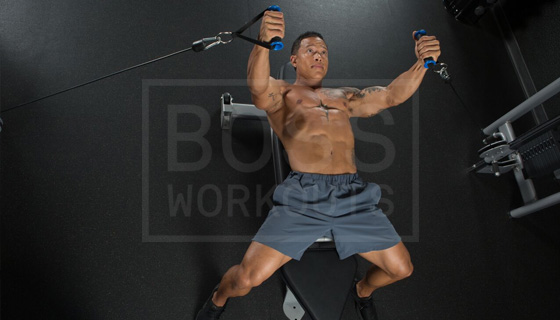
But of you’re wanting to perfect your pectorals, chisel out your chest and thrash your torso then this guide will tell you how to execute the very best exercises.
Because your chest muscles have a pretty even fiber composition you can vary your rep range from heavy reps to failure, to lighter pump reps with high volume.
that way you can attack your chest from every angle.

Using a rack for safety, grab hold of the bar with a grip that’s 1.5 shoulder-width. Wrap your thumbs under the bar so that you have a full grip.
Unrack the bar and start with your shoulder blades pulled back slightly and the bar above your mid-chest. You can maintain a slight arch in your lower back throughout the lift.
Keep your elbows out as you lower the bar down to your chest. Keep control of the weight and stop when the bar is around an inch or so from your sternum.
Your forearms should be pretty much vertical at this point.
From there, drive the bar back to the start position and make sure you don’t completely lock out your elbows.
You can do this one with a pair of dumbbells or even a bar if you prefer. The main thing here is that you get the correct bench angle, which needs to be around -15 degrees for decline (only a small change from flat) and no more than 60 degrees for incline.
Grab a pair of dumbbells and adjust your grip so that your thumbs are facing each other and your palms are facing your feet.
Much like the barbell bench press, begin with your arms extended and in line with your mid-sternum. Your shoulder blades are pulled back slightly and you have a small arch in your lower back.
Keeping your elbows out, and a firm grip of the dumbbells, begin to bring the weights down to your chest, making sure that you move them in a wide arc. You’re aiming to bring your thumbs to the outside of your chest.
At the bottom position, pause briefly and then drive the weights up and inward so that they gently touch at the extended position. Make sure you don’t lock your elbows out to maintain tension on the target muscles.

Start with a pair of dumbbells extended above your chest. Your grip should be in triangle shape, with your thumbs at the top. This means that only the top of the dumbbells will be touching.
Pull your shoulder blades together slightly and maintain a slight arch in your lower back. Your elbows are only slightly bent.
Initiate the movement by lowering the dumbbells, but while maintaining only a slight bend at the elbows – you’re aiming to go as wide as you can and focusing on really opening the chest out.
Your wrists and dumbbells are still maintaining the triangle position throughout.
Go as low towards the floor as your shoulder mobility will allow, but aim to get your wrists in line with your torso at the bottom position if you can.
Once at the bottom, drive the dumbbells up to the starting position, again making sure you maintain the slight bend in your elbows.
You can do dips a few different ways, but to really target the pectorals you should use parallel bars at shoulder-width apart (or slightly wider).
Make sure you have a firm, full grip with your thumbs wrapped around the bars. Begin by taking your body weight while your arms are full extended.
To maximize involvement of the pectorals you should lean into the bars slightly so that your shoulders are in front of your hips. If it helps, bend your knees and lift your heels to counterbalance your weight.
Lower yourself down slowly and under control, making sure that you keep your elbows facing out and your torso leaning forward.
Go as low as feels comfortable, making sure your shoulders don’t roll forwards. If possible, you’re aiming to get your upper arms parallel with the floor.
Once at the bottom, drive upwards while keeping your torso fixed and stable. Don’t lock your elbows at the top of the movement, but make sure you do extend fully.

You can do this either standing or using a bench. You can also simulate flat, incline and decline positions quite easily – it’s a really versatile piece of equipment.
If you want to perform the standing variation, adjust the cable column accordingly.
Take hold of the handles and begin in the stretched position with your elbows slightly bent and your wrists just behind your torso.
Your shoulders should be just in front of your hips and your stance staggered to help with balance and stability.
Similar to dumbbell flyes, you’re aiming to arc the cables around as wide as possible while keeping a slight bend in your elbows. Aim to touch your thumbs together at the finish position.
Return to the start position under control. Keep your body stable throughout.

As a real under-valued exercise, push-ups are all about how you set up.
Place your hands at 1.5 times shoulder-width apart, directly in line with your shoulders.
For the full push-up, rock your weight back onto the balls of your feet and make sure that your body is stable (you should have an imaginary line pass through your ear, shoulder, hip, knee and ankle).
With your elbows fully extended and your shoulder blades pulled together slightly, begin to lower your body to the floor. Maintain stability throughout and make sure your elbows flare outward.
Go as low as feels comfortable, but aim to get your upper arm parallel to the floor if you can.
Once at full range, drive upward, keeping the weight distributed through your pectorals.